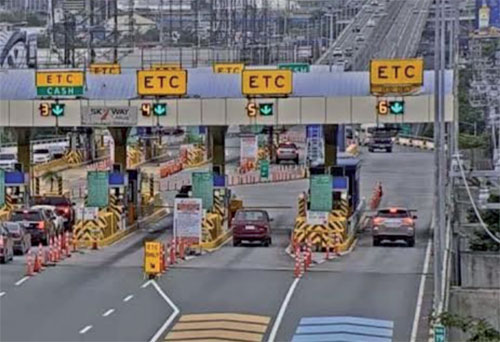Almost six million motorists could save at least 10 minutes of their time when they pass through the expressways using radio frequency identification (RFID) than paying toll in cash.
This transition to cashless toll collection system is being pushed by the government at this time of the pandemic to help reduce the risk of virus transmission and for faster, efficient and seamless travel.
Digitalization in the tollways system is also critical to the country’s economic recovery in the wake of the pandemic.
With this, the Department of Transportation (DOTr) together with the Toll Regulatory Board (TRB), and in cooperation with the private toll operators – Metro Pacific Tollways Corp, San Miguel Corp. and Ayala Corp. – have been working together to implement the toll interoperability since 2017.
The interoperability project, being implemented in three phases, requires toll road companies to make the necessary tweaks in their toll collection systems to make them interoperable and integrated. The idea is to have single RFID sticker that is compatible in all expressways.
The first phase, which is the implementation of cashless payments using RFID technology has been completed, according to TRB executive director Alvin Carullo.
Penetration rate or adoption rate of ETC in 11 expressways in Metro Manila ranged between 68 percent and 90 percent as of end-December in 2020. TRB saw a monthly decline in cashless payment between 63 percent and 82 percent.
The number of RFID users has reached 5.8 million as of mid-January of which 3.2 million are from SMC’s Autosweep and 2.6 million from MPTC.
This is a significant improvement as compared to pre-pandemic.
At present, the tollways companies are conducting tests for the implementation of the second phase which will allow their RFID stickers readable in other expressways. But under this phase, motorist still need to maintain two RFID sticker of each toll operator.
“It bears noting that there is a need to ensure that systems are running smoothly before the implementation of the Phase 2 of the project.” Carullo noted.
MPTC tollways unit NLEX Corp. which operates the North Luzon Expressway (NLEX) and Subic Clark Tarlac Expressway (SCTEX) has conducted re-run of the joint interoperability testing from October 25 to November 13 last year using neology RFID stickers on the 40 vehicles provided by NLEX.
NLEX’s RFID tags were tested at the SMC’s Tarlac-Pangasinan- La Union Expressway (TPLEX) with a read rate result of 98.39 percent, according to TRB.
SMC also completed the final testing conducted at TPLEX using the new MPTC sticker from October 25 to November 7, 2021. A total of 26 vehicles from SMC and MPTC participated in the 14-day testing event.
The SMC test yielded an average of 98 percent reading performance, according to TRB.
To date, the TRB is waiting for the comprehensive reports of both parties.
Carullo said he expects significant progress in the second phase of interoperability, in time for the targeted full implementation of the cashless toll payment system in the second or third quarter this year.
The interoperability project being implemented in three phases requires toll road companies to make the necessary tweaks in their toll collection systems. The idea is to have a single RFID sticker that is compatible in all expressways.
In support to the government’s effort to prevent the spread of the new coronavirus disease 2019 and to achieve efficiency in toll operation, Carullo said the implementation of the full cashless payment system is a must and should be mandated.
In December 2020, the penetration rate of electronic toll collection (ETC) system has reached 90 percent when the government mandated 100- percent cashless toll payment system. But the implementation was suspended indefinitely by DOTr early last year due to opposition of Congress.
The policy was also deferred to allow more motorists, particularly non-regular users of tollways and those living in far-off provinces, ample time to install RFID stickers.
However, ETC penetration rates per expressway had been declining since the government suspended the toll collection system.
Penetration rate or adoption rate of ETC in 11 expressways in Metro Manila ranged between 68 percent and 90 percent as of-end December in 2020. TRB saw a monthly decline in cashless payment, between 63 percent and 82 percent.
Carullo said the TRB secretariat is poised to recommend to the board the implementation of the full cashless transaction in the second or third quarter of 2022.
Meanwhile, toll operators have continued their toll system upgrade in preparation for the mandatory cashless payment.
These expressways include SMC’s South Luzon Expressway, Skyway, NAIA Expressway, Southern Tagalog Aerial Road, TPLEX, MPTC’s NLEX-SCTEX, Cavitex, C5-link and Cavite Laguna Expressway and Ayala Corp.’s Muntinlupa-Cavite Expressway.





